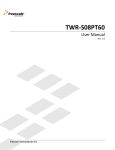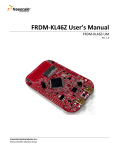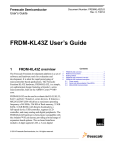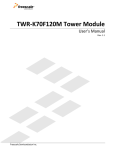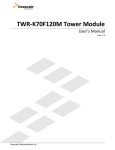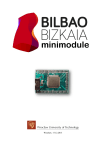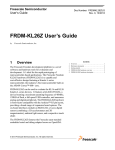Download TWRKV10Z32UG, TWR-KV10Z32 Tower Module User's Guide
Transcript
Freescale Semiconductor, Inc. User’s Guide Document Number: TWRKV10Z32UG Rev. 0, 01/2014 TWR-KV10Z32 Tower Module User’s Guide 1 Overview The KV10 is the entry-level member of Kinetis V series, a Kinetis-based Microcontroller family. On a single chip, it combines the processing power of up to a 75MHz ARM M0+ CPU with up to 32KB Flash, 8KB RAM, a motor control timer and an ADC with the capability to capture two inputs simultaneously (for example, two current phase measurements), within a period of 800nS to 1uS at 12-bit resolution. It has a full set of programmable peripherals including a 6-channel PWM timer to drive a 3-phase complimentary inverter stage, 2x 16 bit ADCs with 2 capture & hold circuits, 2 UART, 1 SPI, I2C, CRC block, analog comparators w/DAC, on-chip/off-chip clock sources, and a 12b DAC. Also included is a Programmable Delay Block module for precise ADC sampling points timing. Each peripheral can be shut down independently to save power. It can work with a power supply voltage range from 1.71V to 3.6V. The KV10 is targeted for low dynamic variable speed sensorless motor control used in industrial pumps, compressors, and fans, power conversion as well as other general purpose applications. © 2014 Freescale Semiconductor, Inc. Contents 1. Overview . . . . . . . . . . . . . . . . . . . . . . . . . 1 2. Hardware description . . . . . . . . . . . . . . . . 2 2.1.Block diagram . . . . . . . . . . . . . . . . . . . 2 2.2.Microcontroller . . . . . . . . . . . . . . . . . . 3 2.3.Clocking . . . . . . . . . . . . . . . . . . . . . . . 3 2.4.System power . . . . . . . . . . . . . . . . . . . 4 2.5.Debug interface . . . . . . . . . . . . . . . . . . 5 2.6.Accelerometer . . . . . . . . . . . . . . . . . . . 8 2.7.User interfaces . . . . . . . . . . . . . . . . . . 9 2.8.Interface connectors . . . . . . . . . . . . . 13 3. Jumper settings . . . . . . . . . . . . . . . . . . . . 15 4. Reference documents . . . . . . . . . . . . . . . 17 5. Revision history . . . . . . . . . . . . . . . . . . . 17 Hardware description The KV10 Tower MCU Module part number is TWR-KV10Z32 and has a 48-LQFP chip soldered directly on the PCB. The module works under -40~ +105 degrees celsius. The following list summarizes the features of the KV10 Tower MCU Module TWR- KV10Z32: • 48-LQFP KV10 Microcontroller • On board OpenSDA with USB connection used to debug code without external debug interface • Header for standard mini Cortex SWD connector used to debug code on either OpenSDA or KV10 with external debug interface • Power indication LED • 10MHz crystal on board for the microcontroller • MMA8451Q Accelerometer connected to I2C channel • 8 LEDs connected with buffers to PWM channels for dimming. • 2 Push buttons for user input or interrupts to the microcontroller • 4 Thermistors for single ended or differential analog inputs • Reset push button for KV10 • Elevator signal supporting TWR-MC-LV3PH • Header to connect to APMOTOR56F800E motor board • Can be powered by external supply such as APMOTOR56F800E motor board and TWR-MC-LV3PH • Headers to connect SCI0 and SCI1 signals to either OpenSDA or elevator board • 2-pin jumper for current measurement 2 Hardware description This section provides specification details for the KV10 MCU Module board TWR- KV10Z32. 2.1 Block diagram A block diagram for the TWR- KV10Z32 is shown in the figure below. TWR-KV10Z32 Tower Module User’s Guide, Rev. 0, 01/2014 2 Freescale Semiconductor Inc. Hardware description Figure 1. KV10 MCU tower module block diagram 2.2 Microcontroller The KV10 package used on the board is 48-LQFP. The MC part number for KV10 is MKV10Z32VLF7. 2.3 Clocking A 10M Hz external crystal which can work under -40C~ +105C, is used for the external clock source of the KV10. The clock signal can be isolated when the EXTAL and XTAL pin are used for the other purpose (GPIO, IIC) via J4 and/or J5. TWR-KV10Z32 Tower Module User’s Guide, Rev. 0, 01/2014 Freescale Semiconductor Inc. 3 Hardware description Figure 2. Clock circuit 2.4 System power The KV10 MCU module can be powered by the OpenSDA circuit (via the Mini-AB USB connector), the Tower Elevator power connections, or the motor connection. The KV10 can work with 3.3V power supply or 1.8V power supply selectable via J1 header. The 3.3V power supply can be from the tower system, 3.3V regulator from 5V power rail coming from USB port, or it can be directly from other tower modules through tower elevators. It can also be directly from the Motor Connector. The power supply source selection from either the 3.3V regulator or the tower elevator is done automatically. The power supply source selection from the tower system and the Motor Connector is also done automatically. The LED indicators for power, reset, target power, and status are present: D11 indicates the 5V power is on from USB port rail and enabled by OpenSDA; D18 indicates the 3.3V power supply is on. VDDA,VREFH and VSSA, VREFL are the analog power supply pins for the microcontroller. These voltage sources supply power to the ADC module. A 0.1uF ceramic bypass capacitor is located as close to the microcontroller power pins to suppress high-frequency noise. A jumper J2 is provided between the system power supply and the power rail to the MCU to allow for current measurements. It also allows external power supply directly to the microcontroller. TWR-KV10Z32 Tower Module User’s Guide, Rev. 0, 01/2014 4 Freescale Semiconductor Inc. Hardware description Figure 3. MCU power 2.5 Debug interface There are two debug interface options provided: the on-board Open Source SDA (OpenSDA) circuit and an external ARM JTAG mini connector (2x5 pins). The KV10 can be debugged with OpenSDA, or the external ARM JTAG mini connector. 2.5.1 OpenSDA The OpenSDA circuit is MK20 based and provides SWD debug interface to the KV10. A standard USB or a male to mini-B male cable can be used for debugging via the USB connection. This interface also supports the USB virtual serial port. This port can be selected to connect to the SCI0 or SCI1 with option jumpers J21 and J22. SCI0 pins used here are PTB16/RXD0, PTB17/TXD0. SCI1 pins used here are PTD0/RXD1, PTD1/TXD1. Default setting is that J21 pin 2-3 has a shunt installed, and J22 pin2-3 has a shunt installed, see figures below. This ensures that SCI0 RXD0/PTB16 and TXD0/PTB17 are used for OpenSDA COM port interface. The OpenSDA firmware is preprogrammed to support KV10 debugging. TWR-KV10Z32 Tower Module User’s Guide, Rev. 0, 01/2014 Freescale Semiconductor Inc. 5 Hardware description Figure 4. OpenSDA RXD source select Figure 5. OpenSDA TXD source select TWR-KV10Z32 Tower Module User’s Guide, Rev. 0, 01/2014 6 Freescale Semiconductor Inc. Hardware description 2.5.2 ARM JTAG/SWD mini connector The Cortex-M Debug SWD connector J17 is a standard 2x5-pin (0.05") connector providing an external debugger cable with access to either the SWD interface of the KV10 or the OpenSDA microcontroller MK20. Three headers (J18 to J20) are used to select which microcontroller will be interfaced. By default pin 2-3 are short on these headers, this ensures that the SWD interface connects to KV10. Furthermore J29 is VDD select for J17 pin1, the default pin 1-2 of J29 is short. Table 1. ARM JTAG/SWD mini connector J17 description Pin Function Connection to KV10 Connection to OpenSDA K20 1 VTref Target MCU power supply Target MCU power supply 2 SWDIO/TMS PTA3/SWD_DIO JTAG_TMS 3 GND GND GND 4 SWDCLK/TCK PTA0/SWD_CLK JTAG_TCLK 5 GND GND GND 6 SWO/TDO NC JTAG_TDO 7 NC NC NC 8 TDI NC JTAG_TDI 9 NC NC NC 10 RESET PTA20/RESET_b K20_RESET Table 2. J18 connector description Pin Usage Description 1 K20 JTAG_TCK_SI Pin 1-2 short: debugger interface to K20; Pin 2-3 short: debugger interface to KV10 (default setting) 2 SWDCLK — 3 KV10 SWD_CLK — Table 3. J19 connector description Pin Usage Description 1 K20 JTAG_TMS_SI Pin 1-2 short: debugger interface to K20; Pin 2-3 short: debugger interface to KV10 (default setting) 2 SWDIO — 3 KV10 SWD_IO — TWR-KV10Z32 Tower Module User’s Guide, Rev. 0, 01/2014 Freescale Semiconductor Inc. 7 Hardware description Table 4. J20 connector description Pin Usage Description 1 K20 RESET Pin 1-2 short: debugger interface to K20; Pin 2-3 short: debugger interface to KV10 (default setting) 2 /RESET — 3 KV10 RESET — Table 5. J29 connector description Pin Usage Description 1 KV10 VDD_PULL Pin 1-2 short: debugger interface to K20; Pin 2-3 short: debugger interface to KV10 (default setting) 2 VDD_JTAG(SWD) — 3 K20 VDD(+3.3V) — 2.6 Accelerometer An MMA8451Q digital accelerometer is featured on-board. This accelerometer is connected to KV10 via I2C interface 0 with headers for isolation: J7 to J10. Table 6. MMA8451Q connection description Pin Connection to KV10 SCL SCL0/PTC6, with header SDA SDA0/PTC7, with header INT1 PTB3, with header INT2 PTA2, with header SA0 HIGH Table 7. J7 connector description Pin Usage Description 1 Accelerometer SDA Pin 1-2 short: KV10 SDA0 to accelerometer (default setting); Pin 2-3 short: KV10 SDA0 to other places 2 KV10 SDA0/PTC7 — 3 SDA0/PTC7 to other places than the accelerometer — TWR-KV10Z32 Tower Module User’s Guide, Rev. 0, 01/2014 8 Freescale Semiconductor Inc. Hardware description Table 8. J8 connector description Pin Usage Description 1 Accelerometer INT1 Pin 1-2 short: KV10 PTB3 to accelerometer (default setting); Pin 2-3 short: KV10 PTB3 to other places 2 KV10 PTB3 — 3 PTB3 to other places than the accelerometer — Table 9. J9 connector description Pin Usage Description 1 Accelerometer SCL Pin 1-2 short: KV10 SCL0 to accelerometer (default setting); Pin 2-3 short: KV10 SCL0 to other places 2 KV10 SCL0/PTC6 — 3 SCL0/PTC6 to other places than the accelerometer — Table 10. J10 connector description Pin 2.7 2.7.1 Usage Description 1 Accelerometer INT2 Pin 1-2 short: KV10 PTA2 to accelerometer (default setting); Pin 2-3 short: KV10 PTA2 to other places 2 KV10 PTA2 — 3 PTA2 to other places than the accelerometer — User interfaces Push button Two push buttons (SW1 and SW2) are connected to GND and GPIO with LLWU pin interrupt signals (PTA4 and PTB0) to support waking KV10 up from LLS mode via LLWU pin interrupt. One push button switch (SW3) is connected to GND and KV10 /RESET_b pin. When there is a reset, D16 LED will be lit. 2.7.2 User LEDs There are 8 LEDs driven directly by FTM0 and GPIO pins of the MCU via buffers. The connection of LEDs to MCU pins are shown below: TWR-KV10Z32 Tower Module User’s Guide, Rev. 0, 01/2014 Freescale Semiconductor Inc. 9 Hardware description Table 11. LED connection description LED # KV10 pin Description LED0 PWM0/PTC1 Yellow/green LED1 PWM1/PTE25 Yellow LED2 PWM2/PTC3 Yellow/green LED3 PWM3/PTC4 Yellow LED4 PWM4/PTD4 Yellow/green LED5 PWM5/PTD5 Yellow LED6 ENC_PHASE_B/PTD6 Orange LED7 ENC_PHASE_C/PTD7 Red TWR-KV10Z32 Tower Module User’s Guide, Rev. 0, 01/2014 10 Freescale Semiconductor Inc. Hardware description Figure 6. LED connection 2.7.3 Thermistor There are four thermistors (RT1-4) near the corners of the board that can be used as single ended or differential analog inputs to the KV10. In addition to each thermistor there is a resistor between the thermistor and 3.3V system power supply and another resistor between the thermistor and ground. The thermistors are all 10K ohm parts but the associated divider chain uses different resistors. This makes the voltage across the thermistor larger or smaller and provides the ability to try the different gain settings on the analog channels. All four thermistor circuits are designed to provide usable differential inputs over the temperature range of 90°C to -20°C. RT2 and RT4 both give a differential voltage of ~1.65V at 25°C. RT1 gives a differential voltage of ~0.10V and RT3 gives a differential voltage of ~0.28V at 25°C. In addition to the thermistor voltage divider chain each thermistor has a 0.1 uF capacitor in parallel. Each thermistor circuit also has a header (J11 to J14, default settings: pin 1-2 short, pin3-4 short on these headers) that TWR-KV10Z32 Tower Module User’s Guide, Rev. 0, 01/2014 Freescale Semiconductor Inc. 11 Hardware description allows the thermistor to be disconnected from the analog inputs to the KV10. If a user wishes to apply an external analog value these headers may be removed and the external analog signal attached to the KV10 side of the headers. Finally, each analog input to the KV10 has a 100 ohm series resistor and a capacitor as a low pass filter. This helps protect the KV10 from electrostatic discharges and lowers the impedance of the analog signal so that it can be sampled with less noise. Figure 7. Thermistor inputs TWR-KV10Z32 Tower Module User’s Guide, Rev. 0, 01/2014 12 Freescale Semiconductor Inc. Hardware description 2.8 2.8.1 Interface connectors Motor connector The KV10 board can be connected to a motor control board such as the APMOTOR56F8000E. The motor control connector (female) is on the bottom of the board to provide a convenient connection to the motor control board. Some of the KV10 pins are connected to the motor control connector. Those pins associated with analog inputs have 100 ohm resistors in series to provide some ESD protection for the analog inputs of the KV10. Those pins providing analog signals from the motor control board have 220 pF caps with the resistors to provide a low pass filter. The connector pin out is shown in the following table. Table 12. 40-Pin motor connector J15 description Pin# Signal Connection Function Pin# Signal Connection Function 1 +3.3V power supply from motor board External Power supply 2 PTE16/ADC0_SE1/ADC1_SE0 ADC 3 GND GND 4 RESET_b/PTA20 RESET 5 TXD0/PTB17 TXD 6 PTC0/ADC1_SE11 ADC 7 RXD0/PTB16 RXD 8 GND GND 9 FTM0_CH0/PTC1 PWM0 10 ADC0_SE5/PTE17 ANA0, DC Bus voltage 11 FTM0_CH1/PTE25 PWM1 12 ADC0_SE4/PTE21 ANA1, DC Bus current 13 FTM1_CH0/PTD6 T0, Phase A Zero crossing/ Hall effect 14 PTA4/NMI GPIO, LED6 on motor board, GREEN 15 FTM1_CH1/PTD7 T1, Phase B Zero crossing/ Hall effect 16 GND GND 17 FTM2_CH0/PTA1 T3 18 ADC0_SE6/PTE18 ANB0, Phase A BEMF 19 FTM2_CH1/PTA2 T2, Phase C Zero crossing/ Hall effect 20 ADC0_SE9/PTB1 ANB1, Phase B BEMF 21 PTC7/SDA0 GPIO 22 ADC0_SE7/PTE19 ANB2, Phase C BEMF 23 PTC6/SCL0 GPIO 24 GND — TWR-KV10Z32 Tower Module User’s Guide, Rev. 0, 01/2014 Freescale Semiconductor Inc. 13 Hardware description Table 12. 40-Pin motor connector J15 description 25 SWD_DIO/PTA3 TDI/GPIO 26 PTE24 GPIO, LED3, YELLOW on motor board 27 SWD_DIO/PTA3 TDO/GPIO 28 PTE30 GPIO, LED2, RED on motor board 29 SWD_CLK/PTA0 TCK/GPIO 30 FTM0_CH2/PTC3 PWM2 31 PTC5 GPIO 32 FTM0_CH3/PTC4 PWM3 33 PTC0/ PDB0_EXTRG GPIO,LED5,RED on motor board 34 FTM0_CH4/PTD4 PWM4 35 PTE20/ ADC0_SE0 ADC 36 FTM0_CH5/PTD5 PWM5 37 PTB2/ADC0_SE1 ADC 38 PTB0/ ADC0_SE8 ADC 39 PTB3/ADC0_SE10 ADC 40 PTD1/ADC0_SE2 ADC 2.8.2 Aux peripheral connector Aux peripheral connector 1 is designed to facilitate the evaluation of digital functions. Table 13. Aux peripheral connector1 J6 description Pin# Signal Connection Pin# Signal Connection 2 VDD 1 VSS 4 PTA1 3 PTA0 6 PTA3 5 PTA2 8 VSS 7 PTA4 10 PTB17 9 PTB16 12 PTB3 11 PTB2 14 PTE25 13 PTE24 16 PTC3 15 PTC2 18 PTC5 17 PTC4 20 PTC7 19 PTC6 22 PTD1 21 PTD0 24 PTD3 23 PTD2 26 PTD5 25 PTD4 28 PTD7 27 PTD6 TWR-KV10Z32 Tower Module User’s Guide, Rev. 0, 01/2014 14 Freescale Semiconductor Inc. Jumper settings Aux peripheral connector 2 is designed to facilitate the evaluation of analog functions. Table 14. Aux peripheral connector2 J16 description Pin# Signal Connection Pin# Signal Connection 2 VDDA 1 VSSA 4 VREFH 3 VREFL 6 PTE17/ADC0_SE5/ADC1_SE5 5 PTE16/ADC0_SE1 8 PTE19/ADC0_SE7/ADC1_SE7 7 PTE18/ADC0_SE6 10 PTE21/ADC0_SE4 9 PTE20/ADC0_SE0 12 PTE29/ CMP0_IN5/CMP1_IN5 11 PTE30/ADC1_SE4 14 PTC1/ADC1_SE3 13 PTC0/ ADC1_SE11 16 PTC3/CMP1_IN1 15 PTC2/ADC0_SE11 18 PTB1/ ADC1_SE9 17 PTB0/ ADC0_SE8 20 PTB3/ADC1_SE2 19 PTB2/ADC0_SE10 3 Jumper settings The following table provides the jumper options. The default installed jumper settings are presented in the shaded boxes. Table 15. Jumper table (default settings highlighted) Jumper J1 J2 J3 J4 J5 J7 Option KV10 power supply select Setting Description 1-2 +1.8V power supply 2-3 +3.3V power supply KV10 power connection ON Connect power supply to KV10 OFF Isolate KV10 from power (connect an ammeter to measure current) PTB0 select 1-2 Connect PTB0 to elevator 2-3 Connect PTB0 to SW2 ON Connect one terminal of crystal to KV10 EXTAL0/PTB18 pin OFF Isolate one of terminal of crystal to KV10 ON Connect the other terminal of crystal to KV10 XTAL0/PTA19 OFF Isolate the other terminal of crystal to KV10 1-2 Connect SDA0 to elevator J24 A8 pin and J6 2-3 Connect this pin to accelerometer(U6) PTA18 select PTA19 select I2C0 SDA0(PTC7) selection TWR-KV10Z32 Tower Module User’s Guide, Rev. 0, 01/2014 Freescale Semiconductor Inc. 15 Jumper settings Table 15. Jumper table (default settings highlighted) J8 J9 J10 J11 J12 J13 J14 J18 J19 J20 PTB3 selection 1-2 Connect PTB3 to MMA8451Q Accelerometer 2-3 Connect PTB3 to elevator J24 and auxiliary connector J6 I2C0 SCL0(PTC6) selection 1-2 Connect SCL0 to elevator J24 A7 pin and J6 2-3 Connect this pin to accelerometer(U6) PTA2 selection 1-2 Connect PTA2 to MMA8451Q Accelerometer 2-3 Connect PTA2 to elevator J24 and auxiliary connector J6 RT1 connection with KV10 PTE16 RT1 connection with KV10 PTE17 1-2 Connect one terminal of RT1 to KV10 PTE16 pin Open Isolate one terminal of RT1 to KV10 PTE16 pin 3-4 Connect one terminal of RT1 to KV10 PTE17 pin Open Isolate one terminal of RT1 to KV10 PTE17 pin RT2 connection with KV10 PTE18 RT2 connection with KV10 PTE19 1-2 Connect one terminal of RT2 to KV10 PTE18 pin Open Isolate one terminal of RT2 to KV10 PTE18 pin 3-4 Connect one terminal of RT2 to KV10 PTE19 pin Open Isolate one terminal of RT2 to KV10 PTE19 pin RT3 connection with KV10 PTE20 1-2 Connect one terminal of RT3 to KV10 PTE20 pin Open Isolate one terminal of RT3 to KV10 PTE20 pin RT3 connection with KV10 PTE21 3-4 Connect one terminal of RT3 to KV10 PTE21 pin Open Isolate one terminal of RT3 to KV10 PTE21 pin RT4 connection 1-2 with KV10 PTB3 Open Connect one terminal of RT4 to KV10 PTB3 pin RT4 connection 3-4 with KV10 PTB2 Open Connect one terminal of RT3 to KV10 PTB2 pin JTAG SWDCLK select 1-2 Connect to OpenSDA 2-3 Connect to KV10 JTAG SWDIO select 1-2 Connect to OpenSDA 2-3 Connect to KV10 JTAG SWD reset 1-2 2-3 Connect one terminal of RT3 to KV10 PTB3 pin Connect one terminal of RT3 to KV10 PTB2 pin Connect to OpenSDA Connect to KV10 TWR-KV10Z32 Tower Module User’s Guide, Rev. 0, 01/2014 16 Freescale Semiconductor Inc. Reference documents Table 15. Jumper table (default settings highlighted) J21 RXD source selection J22 TXD source selection J25 PTC3 select J26 OpenSDA reset signal to KV10 J27 J28 J29 4 1-2 Connect KV10 PTB16 pin to elevator J24 A41 pin 2-3 Connect KV10 PTB16 pin to OpenSDA RXD 3-4 Connect KV10 PTD0 pin to OpenSDA RXD 4-5 Connect KV10 PTD0 pin to elevator J24 A43 pin 1-2 Connect KV10 PTB17 pin to elevator J24 A42 pin 2-3 Connect KV10 PTB17 pin to OpenSDA TXD 3-4 Connect KV10 PTD1 pin to OpenSDA TXD 4-5 Connect KV10 PTD1 pin to elevator J24 A44 pin ON Connect PTC3 Connect PTC3 to J24 A38 and B47pin OFF Connect PTC3 to J24 B47pin only ON Connect OpenSDA reset signal to KV10 OFF Isolate OpenSDA reset signal to KV10 when test KV10 IDD current OpenSDA ON SWDCLK signal OFF to KV10 Connect OpenSDA SWDCLK signal to KV10 ON OpenSDA SWDIO signal to OFF KV10 Connect OpenSDA SWDIO signal to KV10 JTAG VDD signal select 1-2 Connect KV10 power supply to JTAG pin1 and pull-up voltage of pin2 2-3 Connect OpenSDA +3.3V provided by K20 to JTAG pin1 and pull-up voltage of pin2 Isolate OpenSDA SWDCLK signal to KV10 when test KV10 IDD current Isolate OpenSDA SWDIO signal to KV10 when test KV10 IDD current Reference documents The OpenSDA User’s Guide, available on freescale.com, is a guide for users of the OpenSDA embedded circuit. 5 Revision history Revision number Date Subctantial changes 0 01/2014 Initial release TWR-KV10Z32 Tower Module User’s Guide, Rev. 0, 01/2014 Freescale Semiconductor Inc. 17 How to Reach Us: Information in this document is provided solely to enable system and software Home Page: freescale.com implementers to use Freescale products. There are no express or implied copyright Web Support: freescale.com/support information in this document. licenses granted hereunder to design or fabricate any integrated circuits based on the Freescale reserves the right to make changes without further notice to any products herein. Freescale makes no warranty, representation, or guarantee regarding the suitability of its products for any particular purpose, nor does Freescale assume any liability arising out of the application or use of any product or circuit, and specifically disclaims any and all liability, including without limitation consequential or incidental damages. “Typical” parameters that may be provided in Freescale data sheets and/or specifications can and do vary in different applications, and actual performance may vary over time. All operating parameters, including “typicals,” must be validated for each customer application by customer’s technical experts. Freescale does not convey any license under its patent rights nor the rights of others. Freescale sells products pursuant to standard terms and conditions of sale, which can be found at the following address: freescale.com/SalesTermsandConditions. Freescale, the Freescale logo, and Kinetis are trademarks of Freescale Semiconductor, Inc., Reg. U.S. Pat. & Tm. Off. Tower is a trademark of Freescale Semiconductor, Inc. All other product or service names are the property of their respective owners. ARM and Cortex are registered trademarks of ARM Limited (or its subsidiaries) in the EU and/or elsewhere. All rights reserved. © 2014 Freescale Semiconductor, Inc. Document Number: TWRKV10Z32UG Rev. 0 01/2014


















